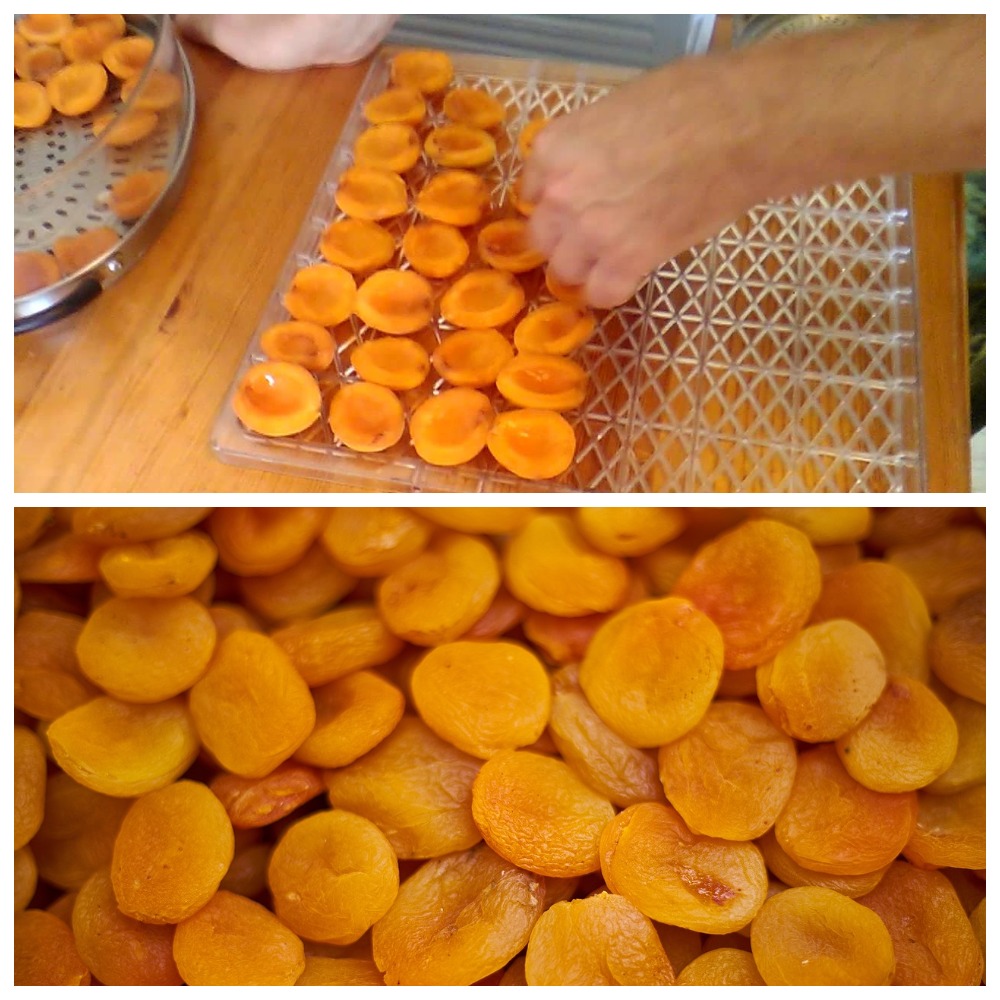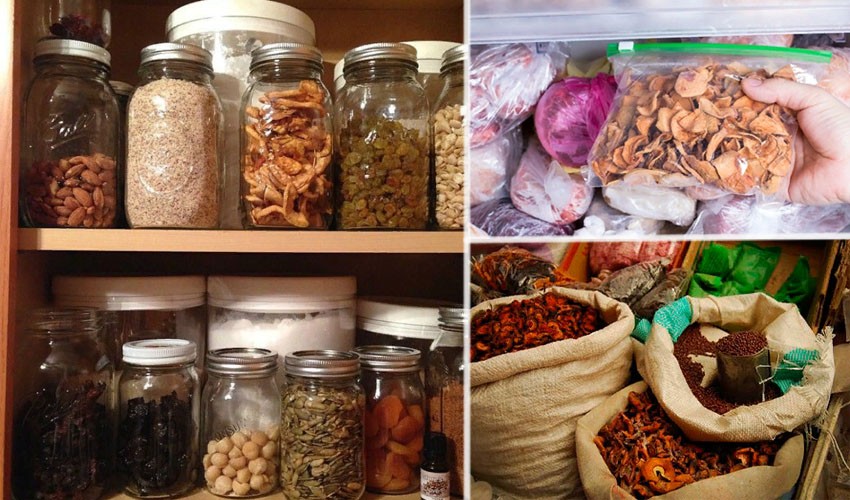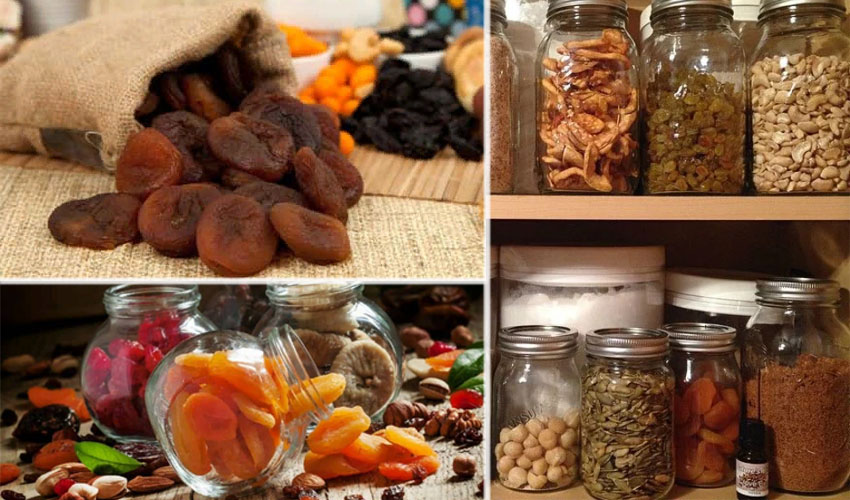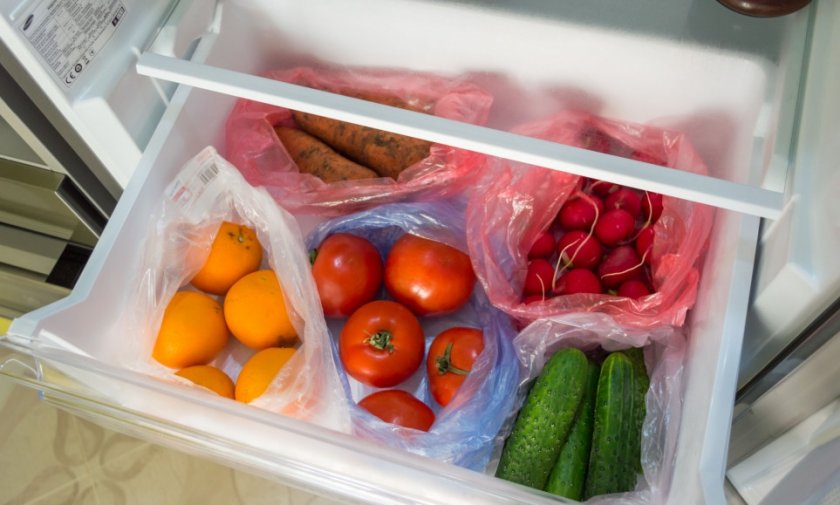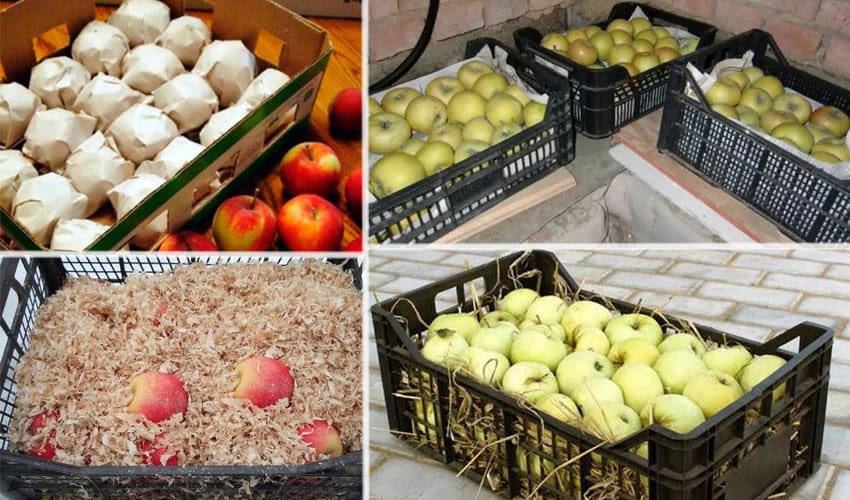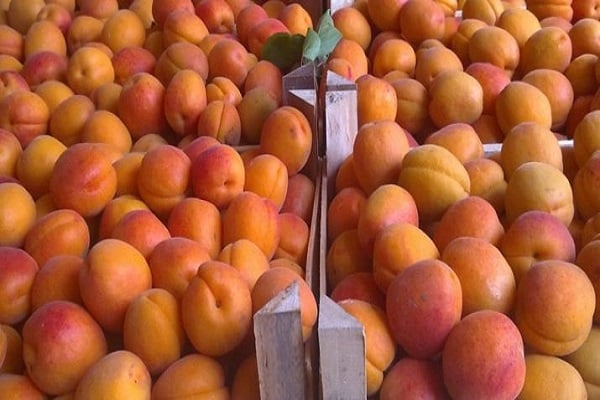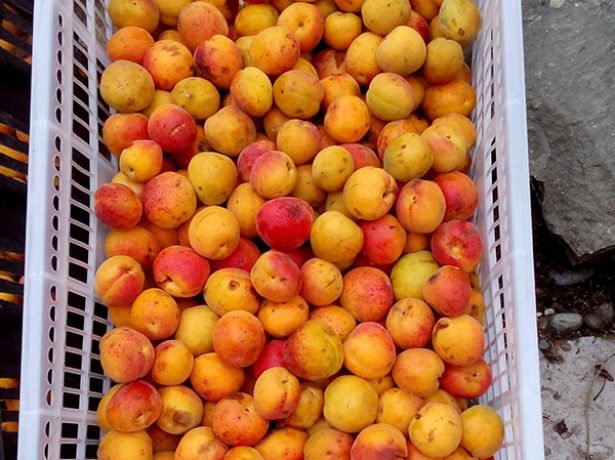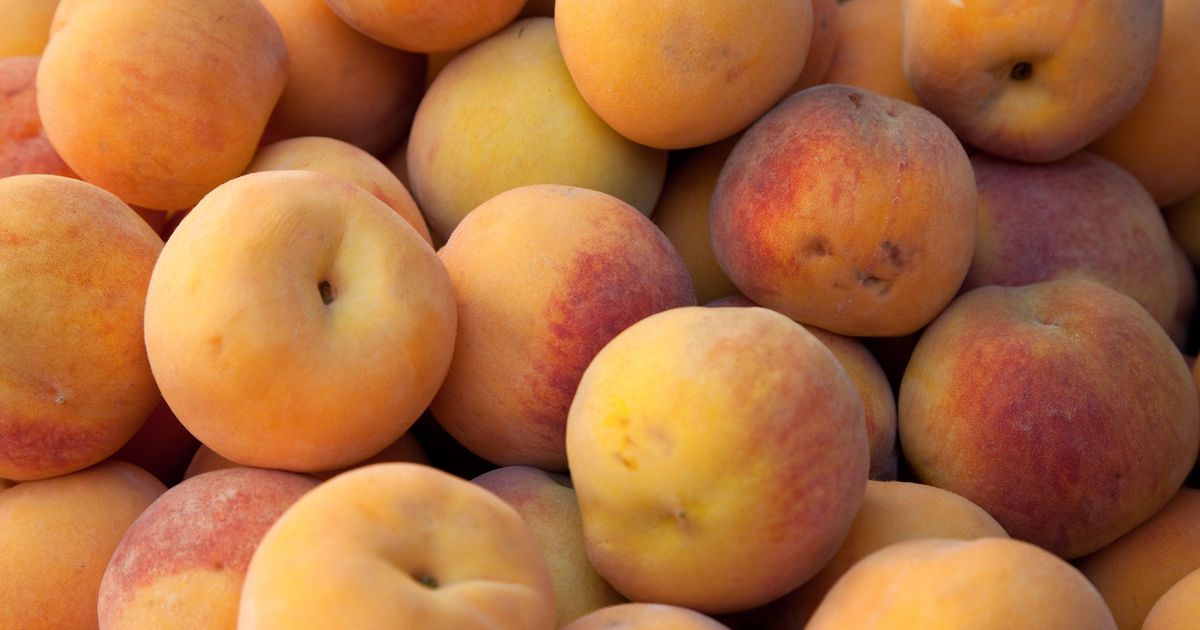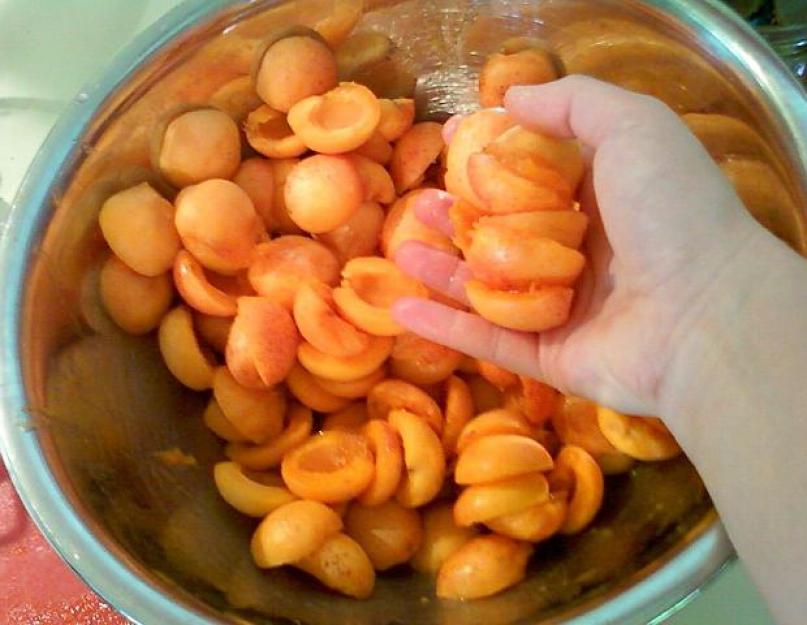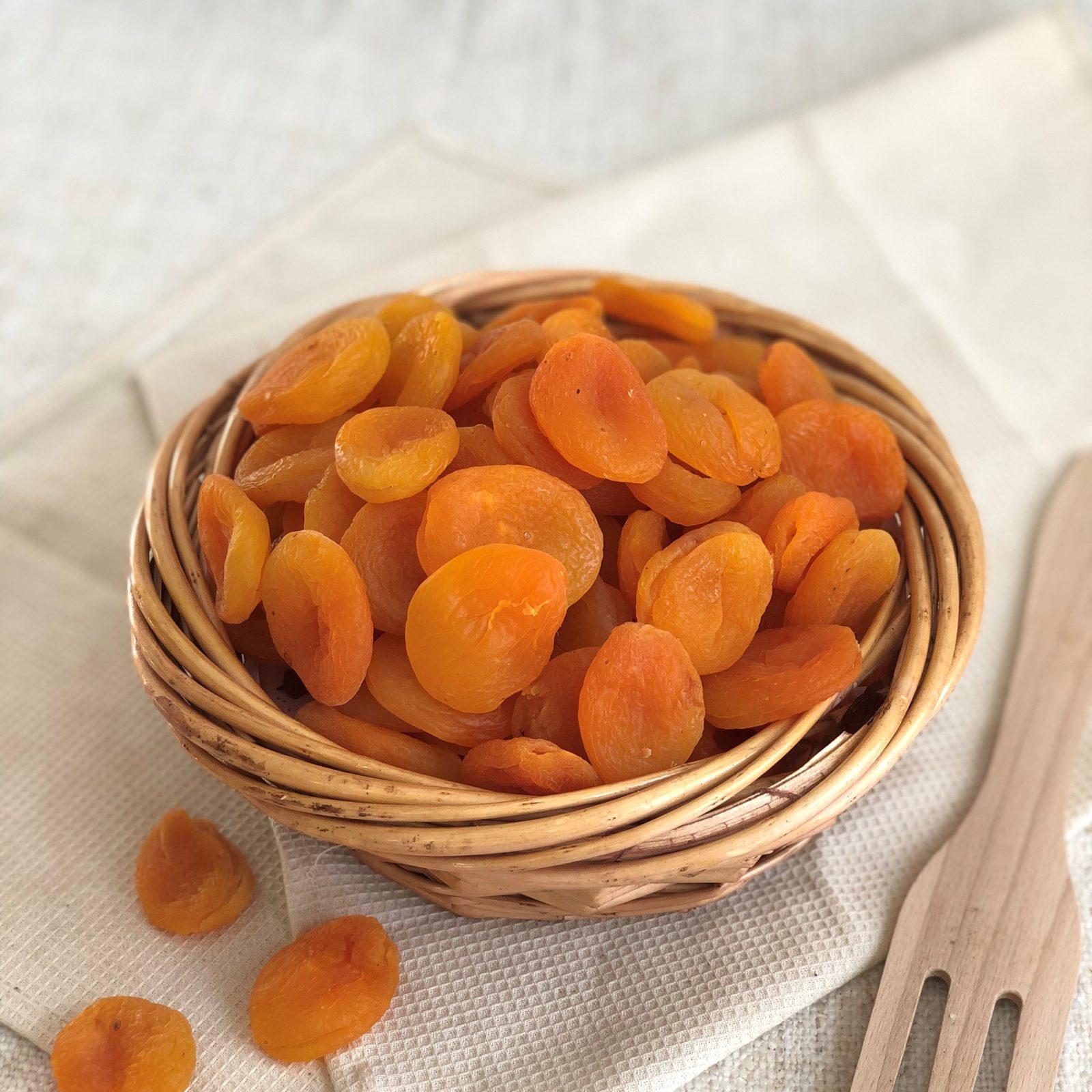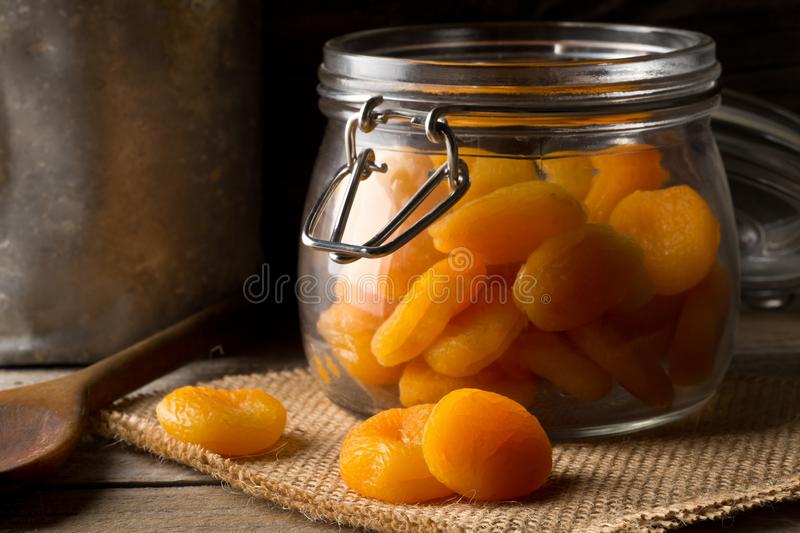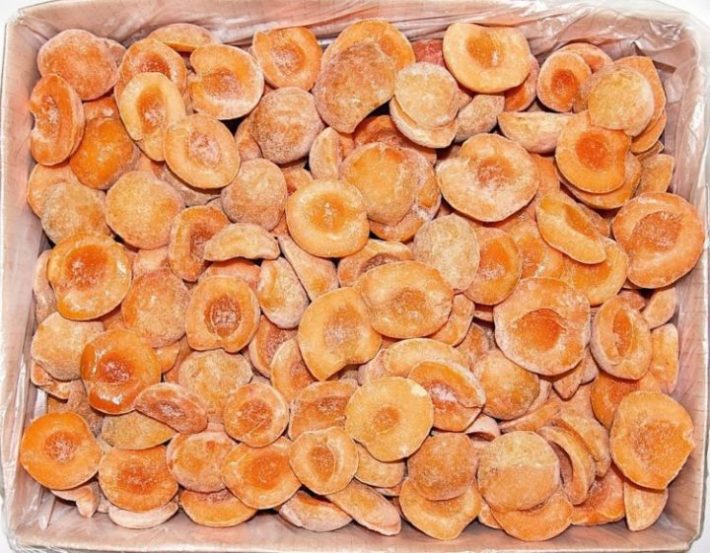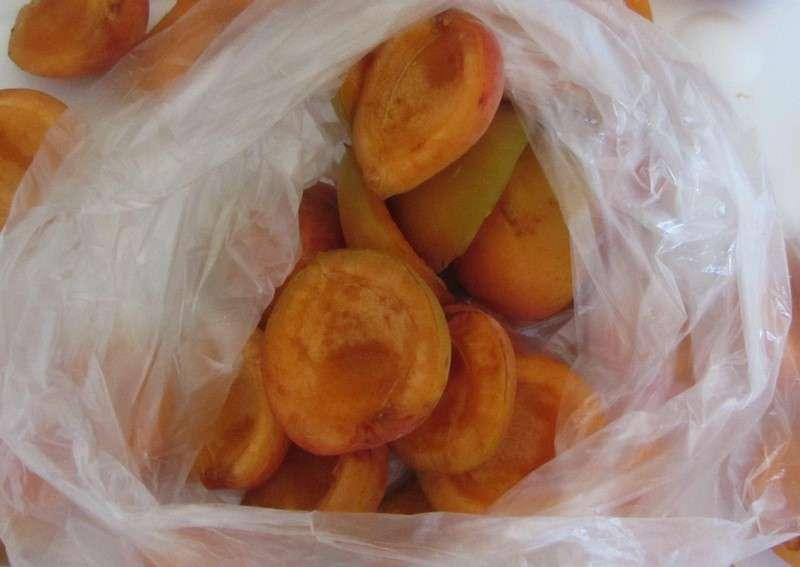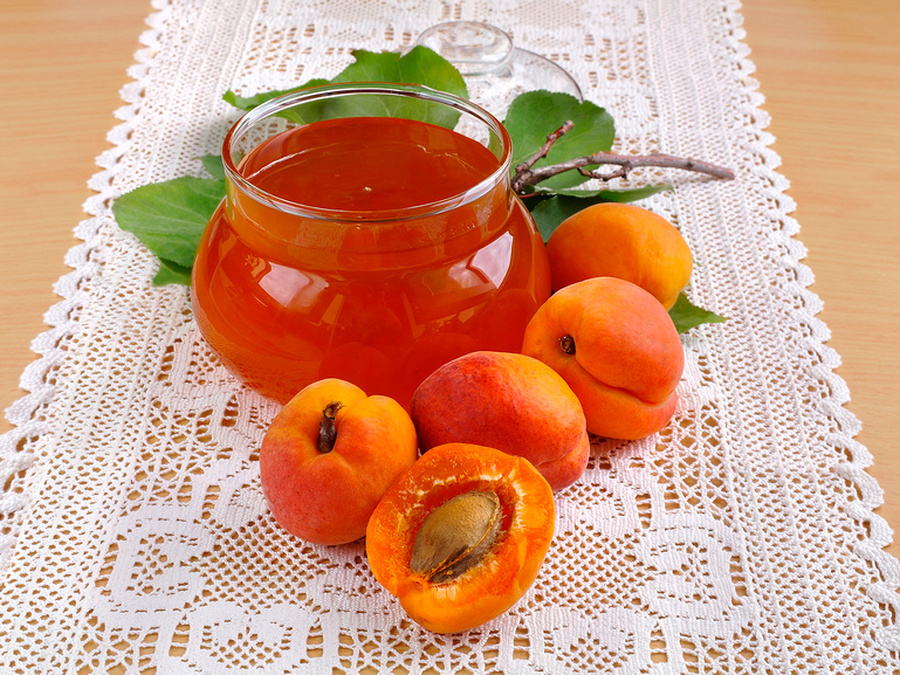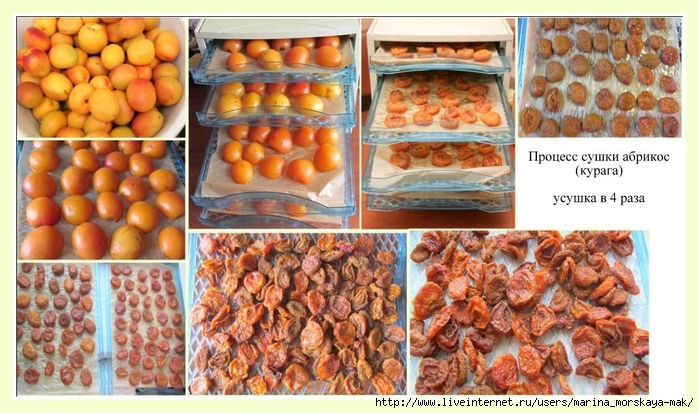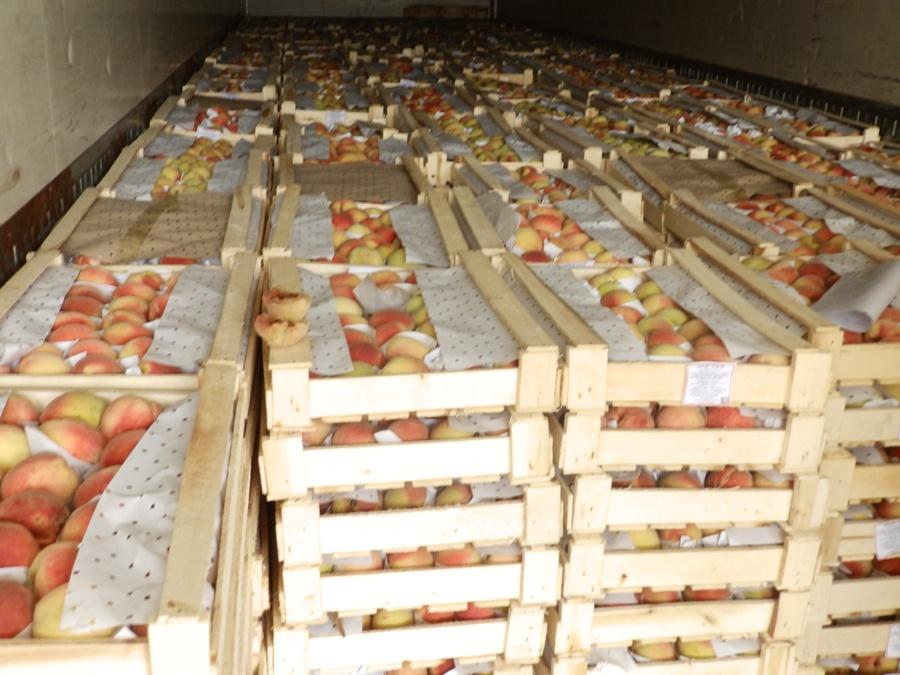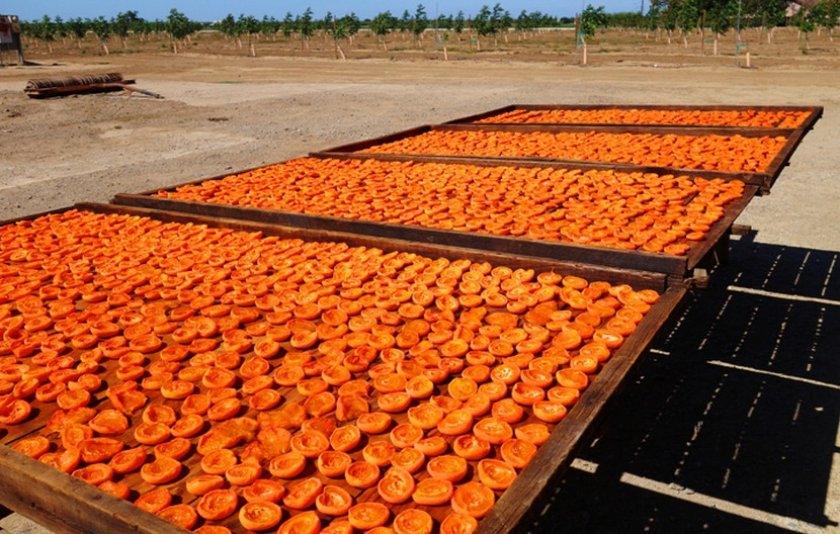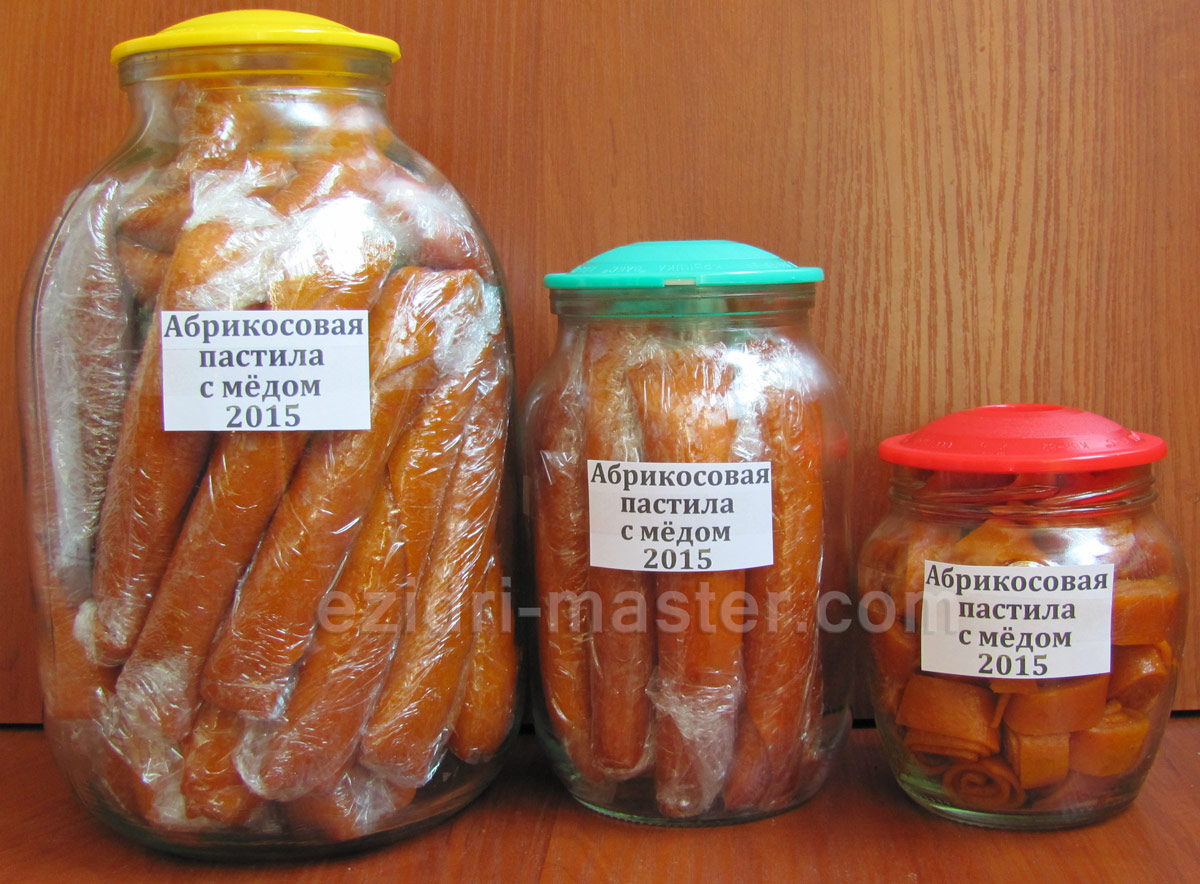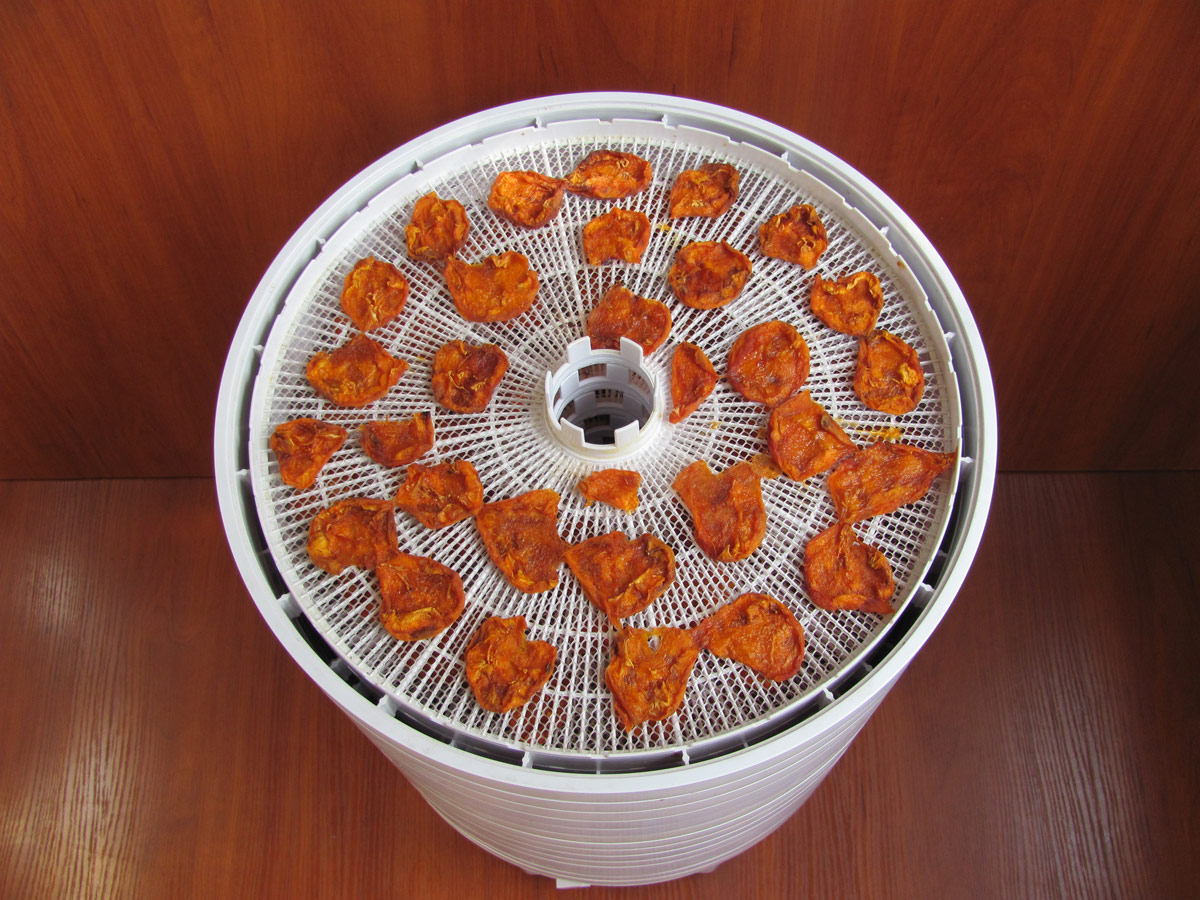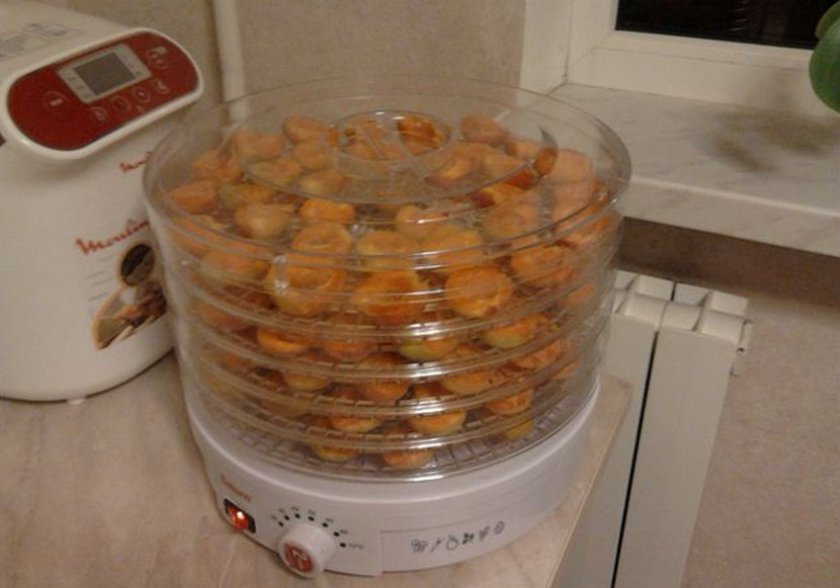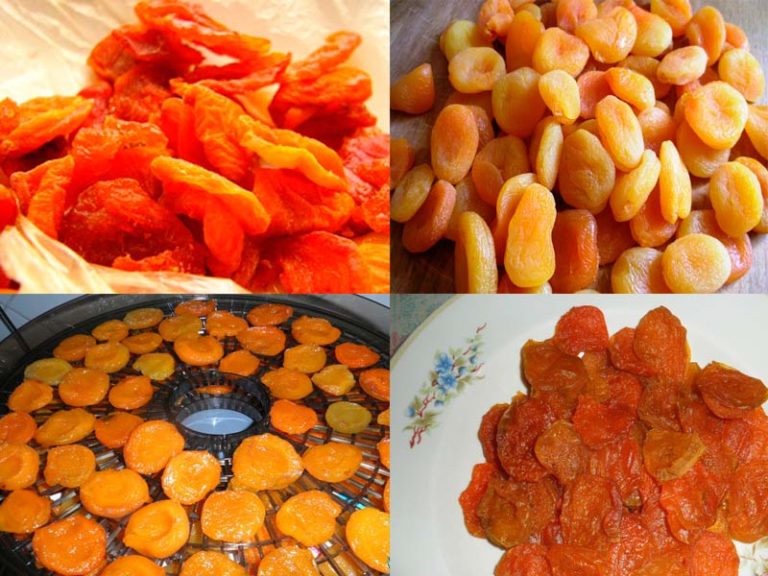Additional tips and tricks
When the question arises of how to properly store dried fruits at home, not many people think about the need to hide the workpiece from sunlight or remove it away from indoor plants. But such requirements are easy to explain:
- overheating of dried fruits occurs under the influence of direct sunlight, especially if they are hermetically sealed. The so-called greenhouse effect promotes the reproduction of beetles and worms;
- dried fruits that are constantly under the sun quickly lose their natural color and begin to taste bitter;
- midges often settle in the soil of indoor plants, which can deposit larvae in the nearby dried fruits.
If you suspect that moths or other parasites have already appeared in the container with dried fruits, you can apply shock heat treatment. Freeze the fruits in the freezer at a temperature of -18 ... -15 ℃, then dry them in the oven. Frost will kill pests, and dried fruits need to be dried in order to return the fruit to its original structure.
Cloves will help keep dried fruits from moths at home. Place some dried seasoning next to the dried fruit and change as needed. Mint has the same effect. Place sprigs of fragrant herbs near the containers with dried fruits - and no uninvited "friend" will get to your tasty supplies.
 Dry cloves and mint will help ward off parasites when storing dried fruits
Dry cloves and mint will help ward off parasites when storing dried fruits

Having learned how to preserve dried fruits for the winter at home, you can purchase them or start harvesting and not worry about saving. Drying apricots, apples, plums will not only save money, but also become a source of useful microelements for the body. Use our advice, and you can pamper your family and friends with natural sweets all year round.
| Type of dried fruit | Storage features |
| Prunes | Dried plums are stored at a temperature not exceeding 20 degrees Celsius for about 3 months. If it is too hot in the apartment, the berries are stored in the freezer. Paper or vacuum bags, glass containers are suitable as packaging. |
| Dried apricots, apricots | If possible, it is better to harvest dried apricots yourself. Such fruits have a lower percentage of moisture compared to factory-grown ones. You need to store dried apricots in a dark place, placing them in a cloth bag. However, long-term storage in bags will lead to excessive drying of dried apricots and the appearance of white bloom. Then the fruit is placed in the freezer. This will help keep them for 2 years. Dried apricots are thawed at a temperature of 20-23 degrees Celsius |
| Raisin | It is undesirable to place raisins in the refrigerator. He loves air, so it is preferable to put him in fabric bags made of cotton or linen. Glass containers are closed with paper instead of a lid. If the raisins dry out, they are sprayed with water and placed in the microwave for 1 minute |
| Dates, figs | These fruits do not keep well at room temperature. Sweet drying is best placed in a vacuum bag, container with a lid and placed in the refrigerator. Plastic bags are not suitable for this purpose. In the preparation process, stocks are not washed. The savings period will be 4 months |
Be sure to read:
How to keep grapes fresh all winter
To protect the fruit from pests, you should follow these recommendations:
- Keep apricots in an airtight container.
- It is best to use plastic or glass dishes. Moles can damage any packages.
- Arrange the dried fruit with orange peels or lavender branches.
Dried apricots are considered a healthy and tasty product that is popular with many people. To achieve success in storing them, it is recommended to choose the right container and observe the temperature and humidity parameters.
Procurement methods
Fragrant preparations from juicy fruits can be enjoyed throughout the winter. There are several ways to prepare apricots for future use.
Drying
You can dry the crop for future use. For this, large, but not too juicy fruits are selected. It should be borne in mind that when drying, the weight of each fruit will decrease by about 6 times. The product can be dried both naturally and in the oven or using a special technique.
The easiest way to dry apricots for the winter in an apartment is to free the fruits from the seeds and string them on a rope. Such garlands of fruits are hung in a well-ventilated, warm room, for example, in the kitchen.

Before drying the apricots, the fruits should be kept in water at room temperature with the addition of lemon juice. To prepare the solution, 1 tsp is taken for every 1 liter of water. juice.
Prepared apricots are laid out in one layer on a baking sheet and left in a cool room for several days.
It is important that there is good air circulation in the room. After that, the workpiece is exposed to the sun for a week.
The finished product is stored in bags, its shelf life is six months.
When using the oven for drying, it is necessary to spread the apricots on a baking sheet and place them in an oven preheated to 50 degrees. Gradually, the temperature should be increased to 70 degrees. So the apricots are dried for 10 hours, turning the fruits all the time.
We put it in the refrigerator
For one to two weeks, fresh fruits will keep well in the refrigerator. Place the fruit in containers with airtight lids. If you leave the apricots in an open container, they will last no longer than two days.
If the temperature in the refrigerator is about 0 degrees, the products will remain fresh for a month. After a month, the fruit will begin to lose its aroma and taste.
Freezing
You can also save crops in the freezer of a regular household refrigerator.
It is easiest to keep apricots in the freezer by dividing the fruits into halves and taking out the seeds, since then they will take up much less space.
Some housewives advise to make fruit puree, place it in containers, close the lid and freeze it like that. So you can use the blanks for cooking.
To keep the workpiece in the freezer, you need to:
- Wash the fruits, selecting only high-quality ones, without spoilage and damage.
- Remove the seeds and cut the apricots into halves.
- Arrange the halves on a cutting board and place in the freezer.
- When the apricots are frozen, transfer them to a bag and put them in the freezer.

So the halves will not get into a lump when frozen. The shelf life of the frozen product is six months.
We store in wooden boxes and paper bags
When laying the crop for storage in a wooden box, each fruit should be wrapped in parchment. Any other thin paper can be used. In no case should the fruit be wrapped in plastic.
The product is laid out in layers in boxes. The boxes should be low. It is enough to put 3-4 layers of apricot in each box.
After laying, the fruit should be checked in order to reject spoiled fruits in time.
When laying in paper bags, each fruit is also wrapped in thin paper. You can't fill the bag with fruits to the top. After laying the apricot, the bag is closed. Store the crop in a cool and dark place with good air circulation.

In the cellar
In the cellar, apricots can lie well for up to a month, but only on condition that the air temperature in the storage is not higher than +5 degrees. Only fruits with intact skin are kept in the cellar.It is convenient to store fruits in boxes or bags in a cellar or basement.
How to store apricots correctly
Bright and juicy apricots are a favorite summer treat for many of us. By the way, this is one of the few fruits in which even the seeds are edible, however, you should not abuse them anyway. In order to enjoy these wonderful fruits for as long as possible, you need to learn how to store them correctly - if stored improperly, these fleshy fruits lose their juiciness, as they quickly lose moisture.
How to choose apricots?
To fully enjoy the unique taste and aroma of apricots, they must be purchased at the height of the season. The best fruits are plump and firm to the touch (they should not deform when pressed) without cracks, painted in rich yellow or orange tones. However, some varieties of apricots also have a pleasant reddish tint. In addition, ripe fruits must be fragrant and sweet.
If suddenly, upon coming home, among the purchased apricots, crumpled fruits were noticed, it is best to put them into action right away - you can just eat them, or you can cook wonderful pastries or delicious sauces with them.
When transporting apricots, it is extremely important not to damage them. And in order to preserve their integrity during storage, do not stack the fruits in heaps
What about unripe fruits?
Unripe fruits must be allowed to ripen in clean paper bags. And so that the apricots quickly become soft and suitable for consumption, fruit bags are stored at room temperature until the very moment of their ripening.
It is also important to try to protect the crop from sunlight. As a rule, unripe fruits can be stored in paper bags for about five days, but most often this is not necessary - usually apricots ripen in two to three days
What to do with overripe apricots?
The soft, dark orange fruits are recommended to be eaten immediately or, like mashed apricots, immediately used for preparing a wide variety of dishes. These apricots make wonderful sauces, great rich compotes and great sweet jams. By the way, overripe fruits often turn out to be much tastier than ordinary ripe apricots!
What if there are a lot of apricots?
If there are a lot of apricots, it is recommended to store them in wooden boxes, after wrapping each fruit with parchment paper. If parchment paper is not available, you can also use small mesh boxes that allow you to place fruits at a certain distance from each other. But to store fruits "in bulk" is not worth it - this measure will not only contribute to a noticeable reduction in the shelf life of apricots, but also significantly complicate their inspection, which is regularly carried out in order to identify spoiled fruits.
It is not recommended to pack the fruits in polyethylene - it is better to use paper bags or tissue paper.

Cold storage
In the refrigerator, these fragrant fruits are easily stored for a week if they are first placed in high-quality sealed containers. At the same time, apricots must be ripe, since they are simply not capable of ripening in the cold.
Unfortunately, apricots do not store as well as many other fruits, however, if stored at around zero degrees, they can sometimes last up to a month. But not all varieties of apricots are suitable for freezing.
Dried apricots
Another great way to preserve apricots is to dry them. Dried fruits, as well as fresh ones, are stored in the refrigerator. If dried apricots are stored at a temperature of more than twenty degrees, they will begin to harden and darken, and after some time they will lose their former nutritional value.If you seal dried apricots in bags, then you can store them at room temperature, however, no more than a month. And packed dried apricots can easily be stored in the refrigerator for up to six months.
Long-term storage conditions apricot
The fruits are used frozen, dried and fresh.
So that in any condition they can survive longer, you should pay attention to their variety and harvest time
Choosing a variety
There are many varieties that differ in taste, aroma, fruit size and ripening time. For long-term storage, it is recommended to use late-maturing crops:
- Light;
- Spark;
- Present;
- Lel;
- Delight;
- Surprise;
- Northern Triumph;
- Joy;
- Hardy;
- Favorite;
- Kichiginsky;
- Honey.
The fruits of these crops are suitable for fresh, dry, frozen and canned storage.
Harvesting rules: timing
The crop is harvested when the fruits are ripe. That is, when they have a characteristic appearance, taste and aroma of the variety.
Important: the collection of fruits must be done in dry weather, after the dew has evaporated. Fruit harvested during the hot day will not store well.
To remove the crop from tall branches, it is recommended to use a fruit picker. Correctly removed apricots will last well
Fruit harvested during hot daytime will not keep well. To remove the crop from tall branches, it is recommended to use a fruit picker. Correctly removed apricots will last well.
Selection of crops for storage
Choose fruits with a firm, even skin. There should be no spots, marks, traces of parasites on the surface. You can check the suitability by pressing. When pressed, the fruit should remain firm.
When sorting, soft, rotten products are set aside separately so that whole specimens are not infected with rot. They can then be processed into compotes.
The five best ways to freeze blueberries
To harvest this berry for the winter, use one of the following recipes.
Freezing whole berries
This method of storing blueberries is good because, after thawing, the workpiece can be used for various purposes: for use as an independent dish, making drinks, baking, cold desserts.
We suggest you freeze according to the following method:
- Dry sorted berries are laid out in a thin layer on a baking sheet with low sides, covered with cling film or baking paper. Try to make sure that the fruits do not come into contact with each other - this will prevent the possibility of freezing.
- The tray is placed in the freezer, in which the quick freeze function is activated for 2-3 hours. During this time, the berries should freeze and become hard.
- When the fruits are frozen, they are packed in portioned sachets, removing all the air from them.
- Blueberry bags are carefully tied and placed in the freezer for long-term storage.
Sugar-coated berries
Freezing blueberries with added sugar prevents the risk of fruits freezing with each other, but must be done quickly so that they do not have time to let the juice flow.
Washed and dried blueberries are placed in shallow plastic containers. Each layer of berries is sprinkled with sugar. For 1 kg of fruit, you should take about 0.5 kg of sugar. The filled containers are closed and placed in the freezer.
If you do not have plastic containers with lids, you can freeze the berries in tight bags, letting air out of them and tying them carefully.
Blueberries with sugar can be stored both in the freezer and on the middle shelf of the refrigerator. The duration of the preservation of fruits reaches 1 year in the absence of temperature fluctuations.
The blank can be used for cooking fruit drinks and compotes, used as a filling for pies, dumplings, muffins.
Berries in syrup
Berries frozen in syrup have a wide range of applications: they can be used to cook jelly, compotes and jams, make smoothies and mousses, add to pies and cakes.
Here is a simple step-by-step recipe for preparing blueberries in syrup:
- Prepare the berries: sort out, rinse under running water and dry.
- Arrange the fruits in portioned containers for freezing.
- Prepare the syrup: combine sugar and water in a 1: 5 ratio in an enamel saucepan, bring to a boil and cool to room temperature.
- Pour the syrup laid out in containers and place in the refrigerator for a couple of hours.
- Tightly close the containers with the chilled workpiece with a lid and place in the freezer for long-term storage.
Blueberry puree
Puree is a great option for storing berries, which have crumpled a little and yielded juice. In the future, such a homemade product can be used as a filling for all kinds of baked goods.
For mashed potatoes, sort through the blueberries, removing leaves, twigs and spoiled fruits. Wash, dry and chop the selected berries in a convenient way: using a blender or a kitchen machine. Divide the wiped mass into portioned containers - these can be small plastic containers, baking or ice tins... Place the completed forms in the freezer.
If you want to prepare sweet puree at the stage of grinding berries, sugar should be added to them. Its amount depends on individual preferences:
- to prepare a sweet mass, the amount of sugar should be equal to the volume of the berries;
- Sour puree may contain 1 part of sweet sand for 2 parts of fruit.
Blueberry juice
Making blueberry juice is a laborious process, but this tasty drink contains the maximum amount of vitamins and can be stored in the freezer for up to 12 months.
To squeeze juice from berries, you should use any available method: use a juicer, meat grinder, blender or wooden crush. The resulting mass can be wiped through a sieve, and the cake can be squeezed out through clean gauze - so the juice will be clean, without pulp. It is not necessary to do this, since the peel of the berries contains the bulk of nutrients.
The juice squeezed from blueberries should be poured into portioned containers. We recommend using clean plastic cups and covering them with cling film. You can also store juice in small bottles and microwave containers.
Do not fill the containers with juice to the very top, as the liquid expands and increases in volume when freezing.
How to prepare drying for long-term storage
In order for dry apricots to retain their taste and color for a long time, you need to choose the right temperature, humidity and dishes.
Determining the packaging
The packaging should not let in sunlight and moisture, prevent the accumulation of condensation inside. Polyethylene and metal are not suitable storage materials for dried apricot. Plastic bags collect moisture and mold. Metal boxes oxidize, imparting an iron flavor to dried apricots.

It is better to put a small amount of apricots in a ceramic, glass dish with a lid.
Boxes
Dried fruits are stored in closed wooden boxes lined with thick paper. For storing apricots and dried apricots, corrugated cardboard boxes are used.
Paper bags
Four-layer paper bags and bags are also used as containers. They are packed in plywood or cardboard boxes.
A place to save
Properly organized storage protects dried fruits from insects. To do this, you need to close up the cracks in the walls. The room must be well ventilated.
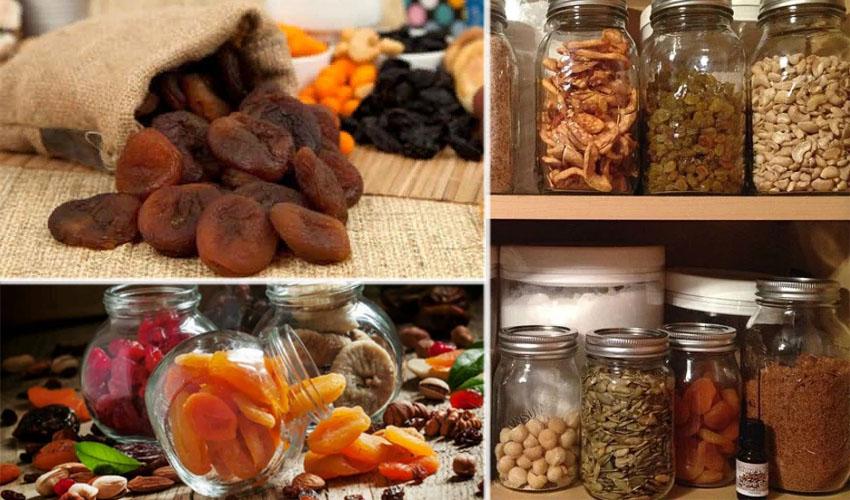
Temperature and humidity
Dried apricots are stored at humidity up to 70% and temperatures from 5 to 20 degrees. At higher heat values, the fruit darkens.
Illumination
The sun's rays heat the air and raise the storage temperature. Therefore, it is better to choose a dark room.
Where to store apricots
To keep the apricot fresh, you should also avoid high humidity and heat. The best storage place in an apartment is a refrigerator.

Indoor conditions
Dried fruits cooked in an electric dryer or dried in the sun will not darken if the temperature in the room does not exceed 20 degrees. Apricots can be dried in summer and stored on the balcony in winter. Several kilograms of drying will fit in a cardboard or wooden box. The package must be tightly closed. At the dacha, it is good to store apricots in a cool cellar.
In fridge
To store apricots, you should find a place on the shelf with vegetables. To prevent the drying from absorbing extraneous odors, it must be wrapped in foil or folded into a glass jar with a tight lid.
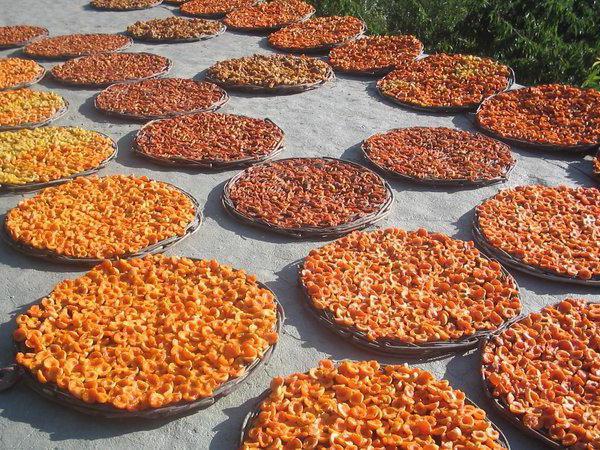
In the freezer
To feast on sweet apricots in winter, they can be dried and stored in the freezer. The apricot will retain its taste and smell in foil or a vacuum container.
Deep freezing of dried fruits at a temperature of -18 degrees increases the shelf life and preserves vitamins. Once stored in the freezer, dried apricots should thaw slowly at room temperature for best flavor. Re-freezing is not desirable, as the product will lose its taste and vitamins.
Freezing and preserving
Freezing is a less popular way to store apricots for long periods of time. Cold destroys their structure and significantly reduces their beneficial properties.
Fruits are frozen whole and in halves. Standard technology:
- Wash the fruits.
- If it is preferable to keep the pitted apricots, remove them.
- Spread the fruits on a flat surface and leave in the freezer for several hours.
- Place apricots in separate bags so that the amount of fruit can be used at a time.
- Send the fruit to the freezer.
In this state, the apricots are preserved until the next harvest.
It is better to make jam or jam from overripe fruits. Conservation is stored for up to five years.
Fragrant and filled with sweet juice, apricots delight with their rich taste.
Anyone who wants to extend the pleasure longer can use their favorite storage methods.
Apricots
Date: 05/13/2017.
Updated: 2020.03.
Storage methods for ripe apricots
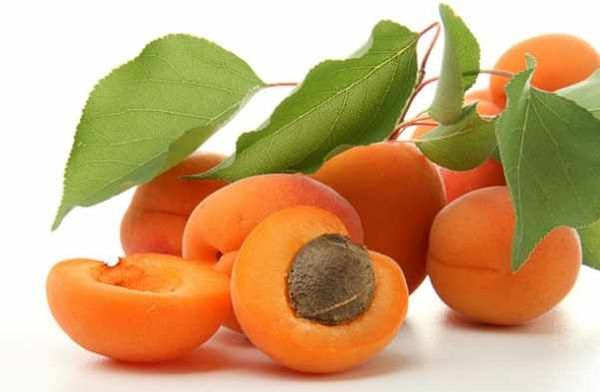
To keep the crop at home for as long as possible, harvesting must be done correctly. Each fruit must be carefully plucked from the tree, avoiding damage to the peel.
If the skin has been damaged, then the fresh appearance of the fruit will not last longer than a few days. This is due to the fact that damage to the peel allows pathogenic microflora to penetrate into the pulp, provoking processes of decay and decomposition in it.
Such specimens very quickly begin to deteriorate, while infecting a normal crop. As a result, you can lose half of the harvest sent to storage.
Today, you can store apricots in the house:
- in boxes;
- in the cellar / refrigerator;
- frozen in the freezer;
- dried.
Let's take a closer look at ways to store at home.
In wooden boxes
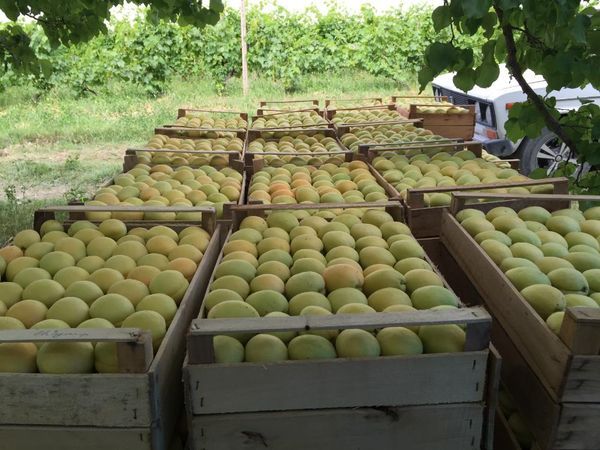
Each piece is wrapped in parchment paper before being placed in wooden boxes. In addition to parchment paper, you can use any thin paper. It is forbidden to wrap in polyethylene.
After laying the crop, it should be periodically inspected in order to have time to identify fruits that have begun to deteriorate at an early stage. Therefore, you cannot add them together, as this will complicate their verification.
In the refrigerator or in the cellar
In the refrigerator, apricots can be kept fresh for up to one week. Before laying, fruits must be placed in a food container, which is hermetically sealed with a lid. It is not recommended to send them for storage without such packaging. If you simply put them in a bowl, the shelf life will be only 1-2 days.
In a situation where the temperature in the refrigerator is at 0 ° C, then the shelf life is increased to 30 days. But even in this case, it is not recommended to delay consumption, since they will still lose their taste by the end of the term.

In the cellar, if the air temperature is about +5 ° C, the crop can be stored fresh for 1 month.Only those fruits are put into the cellar, whose skin was not damaged during the assembly process.
Here, too, the fruits need to be wrapped in paper and placed in boxes. Each copy is placed in a separate cell. If there are no such cells, you should make them yourself. Avoid skin contact with each other. After the laying, a periodic inspection of the crop is mandatory. Otherwise, it may dry out or deteriorate.
Frozen
In the refrigerator, or rather, the freezer, you can freeze apricots. This is a very popular storage method. But here it is necessary to take into account the varietal characteristics. This is due to the fact that the harvest of some species is unsuitable for freezing.
You can freeze both whole fruits and their slices. Before freezing, do the following:
- wash the crop;
- cut and remove bones from them;
- then we lay them out on a flat surface and send them to the freezer.
When the fruits are frozen, they are packed in bags and placed back in the freezer. They will be stored frozen for a year.

Dried
Not all varieties are suitable for drying. To get dried fruits, you need to rinse the fruits well and remove the bone from them. Then they are laid out on any flat surface and left in a draft (always in the shade) for several days. They should not touch each other. Then they are taken out in the sun and left for 7 days. After drying, the product is packed in bags and stored in this form for 6 months in the refrigerator.
Now you know how to keep apricots at home. However, remember that no matter what method of storing the fruits of this stone fruit crop is chosen, you should always adhere to the above rules.
Storage rules and periods
Peaches are a group of fruits that have the ability to ripen when stored after being plucked from the tree. Therefore, for transportation, they choose those that are a little unripe. You should not immediately refuse to buy such a fresh crop. Of course, they will differ in sweetness from those that are ripe on the tree, but for some people this may even be a positive thing. The reason for the lack of sweetness is that sugar production stops after harvest.

In order for the fruits to ripen, peaches must be stored at room temperature. You should not put unripe peaches in the refrigerator for storage, the cold will not allow them to ripen, or it will even contribute to spoilage.
Peaches ripen much faster next to other fresh fruits. In this regard, bananas, apples or pears are placed next to unripe ones. After a couple of days with this storage, the peaches will blush and become juicy and sweet.
A popular question is at what temperature and where to store peaches. Temperature range - from +2 to +8 and air humidity - 85-90%.
Did you know what is the best temperature for storing peaches?
Poll Options are limited because JavaScript is disabled in your browser.
It is best to put only part of the fresh harvest in the refrigerator, and place the rest in the drawers of the pantry or cellar. The fruits are wrapped in paper and laid out in several layers. A small distance between the peaches will only be a plus.
Storing ripe and juicy peaches, unlike unripe ones, next to other fruits is unacceptable in order to avoid damage to the crop.
Such conditions will extend the life of the product by about a month. Fruit should be checked periodically and rotting should be removed. To prolong the preservation, a solution of salicylic acid with alcohol is used to lubricate the fruits. After such a procedure, the crop must be washed before use.
Read on:
How to properly store fresh apricots - proven methods
How to store fresh cherries properly - expert advice
How to store fresh cucumbers correctly so that they do not spoil as long as possible?
Delicious recipes for the correct freezing of peaches
How to keep strawberries fresh and flavorful - proven methods
How to keep bananas fresh at home and why bananas can't be refrigerated
Previous
Fruits and berriesTasty recipes for properly freezing peaches
Next
Fruits and berriesRecipes and rules for freezing cherries for the winter
How to store homemade dried apricots
A natural product is always better than a purchased one, since it is difficult to know how dried apricots are processed in order for them to have an attractive appearance. Housewives often prepare homemade dried apricots in a fruit dryer or oven. For its storage, the same conditions must be observed as for the store
The only important condition: you need to carefully bring them to full readiness so that mold does not form on the product during storage.
It is best to save homemade dried apricots for the winter in the freezer. You can also send it to the refrigerator and store it as described above.
During long-term storage, regardless of the method, it is advisable to check your stocks of dried fruits once a month and, if necessary, reject the blackened fruits. But in the presence of mold, the entire stock should be thrown away immediately, since its spores could penetrate even into a product that is unchanged in appearance.
How fast can you iterate over
Before you start harvesting for the winter, the berry is carefully sorted out. This is done in several ways.
Rinsing with water
The simplest method used by housewives is to rinse the berries in water. To do this, take a wide and deep bowl, fill it with cold water and pour the harvested crop there. Soak in the liquid for about 15 minutes, during which time all debris and dirt will float to the surface. The procedure is repeated several times with a change of water, until the lingonberry becomes perfectly clean.
Wide mesh cleaning
For this method, it is necessary to have a wide metal mesh with small holes appropriate to the size of the berries. The structure is installed with a slight slope so that the berries roll down, and a clean cloth or plastic wrap is spread under it. Then they take a small handful of berries, knead them with a crush and pour the resulting juice over the net.

Vacuum cleaning
Used to quickly clean the berries from debris and a household appliance such as a vacuum cleaner. You will also need a large sieve or mesh with sides.
In small portions, dry berries are poured into a sieve and the air flow is directed from below with a vacuum cleaner. It is important to set the power correctly so that the berries do not fly in different directions along with the leaves and twigs.
Sifting in the wind
If the weather is windy outside, use another simple method. Two containers are prepared: one smaller, from which the lingonberries will be poured, and the second wide, which is set on the ground. They begin to slowly pour the berries down, under strong gusts of wind, the leaves and twigs will fly to the sides, and the heavier lingonberries simply fall into a basin on the ground.
On a rough surface
A small gutter is made of metal and lined with a rough cloth. They begin to pour the berry into the structure, which is installed with a slope. Leaves and branches will remain on the fabric, and heavy berries will fall into the lower container.

